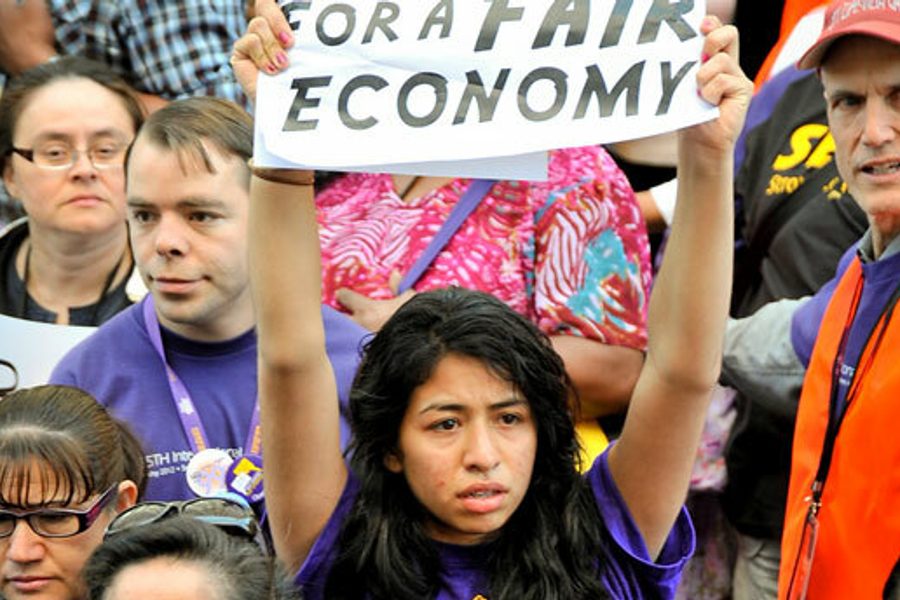
The big banks are back, larger than ever, with profits and stock prices soaring and huge bonuses expected – thanks to taxpayers and the federal government.
That might seem like unabashed good news, but it’s not. The real economy is deeply troubled, with unemployment and foreclosures still rising. Hefty, if uneven, profits at the biggest banks won’t save Main Street. And the rosy impression that the financial system has recovered strengthens the industry’s hand in blocking efforts to prevent another, possibly worse crisis from hitting in the near future.
The most obvious battle is over Democratic proposals to strengthen regulation of the financial sector. But the bigger challenge – one neither Congress nor the administration has fully engaged – is to weaken Wall Street’s political, economic and ideological grip on the country. This would include shrinking the financial sector and its biggest players while redefining the public goals of finance itself.
Banking and finance lobbyists, calling in chits from their huge contributions to politicians in both parties, were busy in recent months trying to kill – or at least weaken – the first significant reform plans: a new Consumer Financial Protection Agency and regulation of financial derivatives.
Both proposals were aimed at four of the underlying and interrelated causes of the current crisis:
Many financial products were and still are deliberately obscure, making it hard for the average person getting a mortgage or credit card, or even for supposedly sophisticated bankers buying credit default swaps, to know what they’re getting.
Many of these non-transparent products – like payday loans or subprime loans – were used to prey on the most vulnerable. In general, banks and financial institutions increasingly relied on fees and penalties – such as hefty charges for overdrafts on debit cards or fees for originating mortgages or for turning bundles of mortgages into securities – instead of the old-fashioned interest income from lending.
As a result, the financial products were increasingly risky to both borrowers and investors, a risk obscured for several years by the run-up in housing prices, a bubble that partly resulted from use of products and practices with little or no regulation.
These products were riskier still because everyone involved – from low-income home buyers to the giant investment banks – took on too much debt. This was not just a result of low interest rates and Chinese savings loaned to finance its trade surplus. The debt boom was also the result of both weak regulation – including inadequate capital requirements for financial institutions and trust in those institutions and the market to assess risk – and a finance-driven view of the economy.
‘Silent coup’ of finance sector
New America Foundation economist Thomas Palley argues that the financial crisis is rooted in a neo-liberal growth model, initiated under Reagan, that was “built on financial booms and cheap imports.” As a result, workers’ pay lagged behind productivity growth, inequality increased, trade deficits grew, and both household and corporate indebtedness climbed.
The financial sector led the march toward globalization and neo-liberalism. The industry grew dramatically, from 2.5 percent of GDP in 1947 to 8 percent in 2006, with the bulk of that growth from the 1980s on.
But financial industry profits and pay grew even faster: From the 1950s to the 1980s, financial firms reaped an average of 10 percent of total U.S. corporate profits. By the 1990s, financial profits fluctuated between 21 and 30 percent of corporate profits. They hit a high of 41 percent this decade. From 1948 to 1982, financial industry pay hovered around the average for private industries – and then shot up to 181 percent of average U.S. pay in 2007, according to MIT economist Simon Johnson.
The financial sector grew in part because of deregulation and development of new products, many designed to profit from growing financial volatility. Often, as with most currency trading, the innovations did little to help the real economy grow, but did create a new global casino.
Not all financial innovations are bad –take, for example, credit cards and mutual funds – even if banks find predatory ways to use them. But many innovations, rather than promoting growth, enriched the financial sector by imposing huge costs on consumers, non-financial corporations and the economy as a whole.
Johnson questions New York University economist Thomas Philippon’s claim that the recent financial boom spurred growth, up until the past decade when it bubbled out of control. Indeed, for every high-tech or Internet startup that blossomed (often owing more to small venture capital firms than to big banks), there were an equal number of disastrous bank-promoted corporate takeovers that plundered and destroyed firms, as in the pending bankruptcy of Simmons Co., the mattress maker.
As physicists and mathematicians were drawn to finance by the fortunes to be made with complex models, the late Nobel economist James Tobin lamented that people were wasting talents on useless speculation and proposed a small tax on all financial transactions. As executives tried to turn every business into a financial play, the booming financial sector led to bubbles that misallocated resources and to debt burdens that squeezed workers.
Traders routinely made millions of dollars a year, fueling a salary arms race among managers and professionals. As factory workers lost their jobs and trade deficits rose, neo-liberal apologists argued that America did not need to make things. It could simply export financial services.
Financial industry leaders, in what Johnson calls a “silent coup,” persuaded politicians and regulators from both parties that banks and other institutions were so sophisticated they could assess and manage risk without any oversight. The government deregulated or failed to regulate, letting financial institutions grow so much that they were “too big to fail,” implicitly guaranteeing a federal bailout if they got in trouble, and thus encouraging riskier behavior.
Now, Johnson suggests, as the industry fights even modest, common-sense rules, these banks may have become too big to regulate.
Bank busting
Banks are supposed to serve one primary purpose – putting savers’ money into the hands of borrowers who can make good use of it, making a profit on the transaction. Because of their key role in the economy, banks got special insurance and regulation in the New Deal. The system worked well for many decades. But especially from the 1970s onward, banks became less interested in performing that useful task of “intermediation” and more obsessed with expanding their empires and enriching top bank employees. A diminishing number of banks now dominate the industry. They are too big, and their cost – including salaries and bonuses – is too high. An industry that should resemble a public utility has become a casino.
Beyond fighting for tougher regulation, including higher capital requirements, simplification or banning of many derivatives, consumer protection, provisions for resolving bank holding company failures, and many other provisions being debated in Congress, Obama and Democratic legislators should break up the biggest banks and limit their size. A Tobin-style transaction tax will help pay for past and future government interventions and shrink the industry.
The banking system needs to be treated as a public utility, with limits on both pay and bonuses, and higher top income-tax rates. Government needs to steer the economy toward ecologically sustainable growth and shared prosperity, heading off another, potentially even worse, finance-driven boom and bust.
David Moberg, a former senior editor of In These Times, was on staff with the magazine from when it began publishing in 1976 until his passing in July 2022. Before joining In These Times, he completed his work for a Ph.D. in anthropology at the University of Chicago and worked for Newsweek. He received fellowships from the John D. and Catherine T. MacArthur Foundation and the Nation Institute for research on the new global economy.









